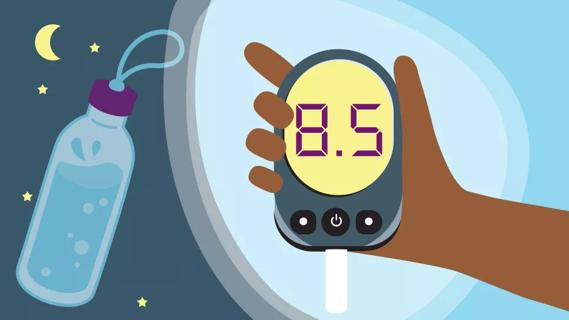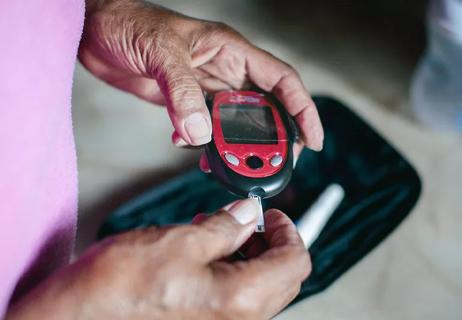Watch your diet, exercise regularly and get a blood glucose level screening early

When you’re pregnant, you get used to peeing in cups — like at every single prenatal checkup. One thing your doctor watches for is glucose (sugar). It may be normal for some to show up in your urine, but if it appears repeatedly or in large amounts, you may have high blood sugar during pregnancy, known as gestational diabetes.
Advertisement
Cleveland Clinic is a non-profit academic medical center. Advertising on our site helps support our mission. We do not endorse non-Cleveland Clinic products or services. Policy
It’s a common condition that’s on the rise in the U.S. One study showed that rates of gestational diabetes increased in people who were pregnant of all races and ethnicities from 2011 to 2019. And because it poses a variety of health risks, it’s important to know what causes this condition and what you can do about it.
Here’s what you need to know about gestational diabetes, including risk factors, screening, treatment and prevention.
The American College of Obstetricians and Gynecologists recommends that people who are pregnant receive a screening for gestational diabetes between 24 and 28 weeks into pregnancy. And your doctor will also likely talk to you about risk factors during your early checkups.
If you have multiple risk factors or if there’s a lot of glucose in your urine during those early prenatal visits, you’ll probably do the screening sooner.
“For people who have risk factors for gestational diabetes, we usually recommend that they get screening earlier in pregnancy — usually in the first trimester,” says maternal-fetal medicine specialist Jeff Chapa, MD.
You’re more likely to have gestational diabetes if you:
Advertisement
Your doctor will ask you to take a test called the oral glucose tolerance test. Here’s what happens:
“When you’re screened early, if that screening is normal, you should get screened again around 24 to 28 weeks when insulin resistance from the placental hormones is nearing its peak,” Dr. Chapa says.
The placenta is the organ that connects you to your baby to nourish it as it grows. The placenta also makes some hormones that work against the action of the insulin that your body makes, so as the placenta grows, so, too, does this “insulin resistance.” In some people, this change is enough to cause an increase in blood sugar levels.
There aren’t any guarantees — and about half of people who get gestational diabetes don’t have any risk factors.
“A lot of people think they can’t get gestational diabetes because have no family history of it and are at a healthy weight,” says Ob/Gyn Salena Zanotti, MD. “But the hormonal changes that happen in pregnancy can still cause you to develop gestational diabetes, so making people aware of the lifestyle changes they can make before they get pregnant is key.”
She suggests adopting the healthiest habits you can — not just during pregnancy, but also before and after.
“Both of these things can make a huge difference,” Dr. Zanotti notes, “but healthy habits make the biggest difference if you adopt them before you get pregnant.”
Advertisement
Gestational diabetes can cause problems for both you and your baby.
“When your body’s insulin supply can’t keep up, extra glucose stays in your blood, and your baby receives more sugar than it needs, which is then stored in their body as fat,” Dr. Chapa explains.
Possible outcomes include:
“Babies born to mothers with diabetes need their blood sugar levels monitored after birth,” Dr. Chapa adds. “Low blood sugars can result in newborn babies from mothers with any type of diabetes, and this can lead to problems for your baby, including seizures.”
If you’re diagnosed with gestational diabetes, your doctor will monitor you closely throughout your pregnancy, but you can still have a healthy baby if you focus on good habits.
“Try not to be worried or alarmed,” Dr. Zanotti reassures. “Your provider will help you manage it so that both you and your baby are as healthy as possible.”
To ensure stable blood sugar levels:
Advertisement
“Fortunately, if we diagnose gestational diabetes early enough, the majority of patients can control it with diet and exercise,” Dr. Zanotti notes. “For a small percentage of people, those things don’t work on their own, and medication may help.”
Most people’s blood sugar levels return to normal after delivery, but your doctor will likely check them during the postpartum period. That’s because having gestational diabetes has some long-term effects, increasing your overall risk of:
In fact, about 10% of people with gestational diabetes have Type 2 diabetes without knowing it, and about half of people with gestational diabetes will have Type 2 diabetes in 10 years.
That means it’s especially important for your primary care physician to monitor your blood sugars and for you to try your best to take control of your health, Dr. Zanotti says. “Being as healthy as you possibly can be will go a long way toward helping reduce your risk.”
Advertisement
Learn more about our editorial process.
Advertisement

Are you loading your grocery cart with enough healthy sources of protein?

Planning ahead, checking in with your care team and being vigilant about blood sugar monitoring can help ensure a safe fast

Type 1 diabetes happens when your body doesn’t make insulin, while Type 2 happens when your body can’t use insulin properly

There is an indirect link between the sweet substance and the condition

The short answer: Yes, but you need to eat it in moderation and keep track of how much you consume

Even a short walk can make a positive difference

Keeping blood glucose levels in a healthy range is critical with diabetes-related vision issues

Updated food label guidelines make it easier to track added sugars in your diet

Type 2 diabetes isn’t inevitable with these dietary changes

Applying a hot or cold compress can help with pain